But with inboxes more crowded than ever, the success of cold email campaigns doesn’t depend only on copywriting or timing. It depends on whether your emails actually get delivered.
That’s where email verification comes in.
What are the best email verification tools for cold outreach in 2026? Let’s find that out.
TL;DR
- Cold outreach only works if emails reach the inbox, and verification is the fastest way to prevent bounces, spam traps, and reputation damage.
- With decaying lists, disposable emails, and strict inbox filters, real-time verification and bulk cleaning are now essential parts of any outreach workflow.
- Bouncer stands out in 2026 with the highest accuracy, catch-all detection, deliverability insights, strong security, and smooth integrations—making it the top choice for cold email campaigns.
Why email verification matters for cold outreach
Cold outreach is still a central channel for sales and marketing teams. With more than 347 billion emails exchanged every day and nearly 4.6 billion active inboxes worldwide, the challenge is no longer volume.
It is reaching the right people at the right time. A clean list of valid email addresses makes the difference between outreach campaigns that generate leads and campaigns that land in spam folders.
This is where an email verification service or email verification software steps in.
By running bulk email verification or even real-time verification at the point of capture, teams reduce bounces, avoid spam traps, and keep outreach performance stable.
For email marketers, using top email verification tools is less about technology and more about protecting investment: the average ROI of email marketing still stands at $36–$42 for every dollar spent, but only if campaigns reach the inbox.

The role of email deliverability in successful cold emailing
Deliverability is the silent driver of every outreach campaign. Even if subject lines are strong and copy is persuasive, poor inbox placement ruins results.
In 2024, average email deliverability rates hovered around 83%, meaning nearly one in six messages never arrived where intended. Anything above 89% is considered good, and rates of 95%+ are excellent.
Email service providers like Gmail or Outlook rely on sender reputation, list hygiene, and content signals to decide whether a message lands in the inbox or the spam folder.
Bulk verification and domain validation improve the odds. One industry study showed that a 1% increase in invalid addresses can reduce inbox placement by 10%.
This makes email verification software more than a technical step, it’s a survival tactic for cold emailing.
Avoiding disposable emails and catch-all domains
Not every address is worth contacting. Disposable email addresses, catch-all domains, and invalid domains often inflate lists but rarely convert.
Some disposable addresses disappear in hours, while catch-all inboxes may redirect everything to a single server, leaving you uncertain whether a person actually received the message.
Email verification APIs and other verification tools flag these risky email addresses before they enter outreach campaigns. Removing them lowers bounce rates, keeps sender reputation steady, and helps sales teams focus on valid prospects.
Many email verification services now integrate email verification directly into sales engagement platforms or email marketing platforms, sometimes even with a Google Sheets plugin for day-to-day list cleaning.
How email validation protects your sender reputation
Sender reputation is like a credit score for email marketers. Internet service providers measure it to decide whether to trust your emails.
High bounce rates, repeated sends to invalid addresses, or too many syntax errors harm reputation quickly. Once damaged, repair takes time and patience, with inbox placement suffering across all campaigns.
By verifying email addresses regularly, through bulk verification, instant verification, or real-time verification, brands can avoid spam traps, reduce invalid emails, and stay clear of spam filters.
This discipline has a direct impact: keeping bounce rates below 2%, ideally under 1%, protects inbox placement and keeps outreach campaigns sustainable.
For sales and marketing teams, the cost of skipping list cleaning is steep.
Nearly 22-30% of contact lists decay every year, and only about 62% of submitted emails are valid.
Without maintenance, even the most user-friendly interface or advanced analytics in a sales engagement platform cannot save performance.
Investing in a free email verifier trial or using email verification API access inside marketing platforms is a simple guardrail against wasted effort and declining returns.
Best email verification tools for cold outreach in 2026
Here’s a list of the best email verification tools for your cold outreach in 2026. Check them out now.
Bouncer – the most accurate bulk email verifier
When it comes to cold email campaigns and email marketing campaigns, no tool stands out quite like Bouncer. Known as the most accurate bulk email verifier on the market, Bouncer combines precision, speed, and ease of use with a caring approach to customer success.
No matter if you’re running lead generation activities, cleaning lists for newsletters, or syncing with email automation tools, Bouncer makes your emails land in the inbox.
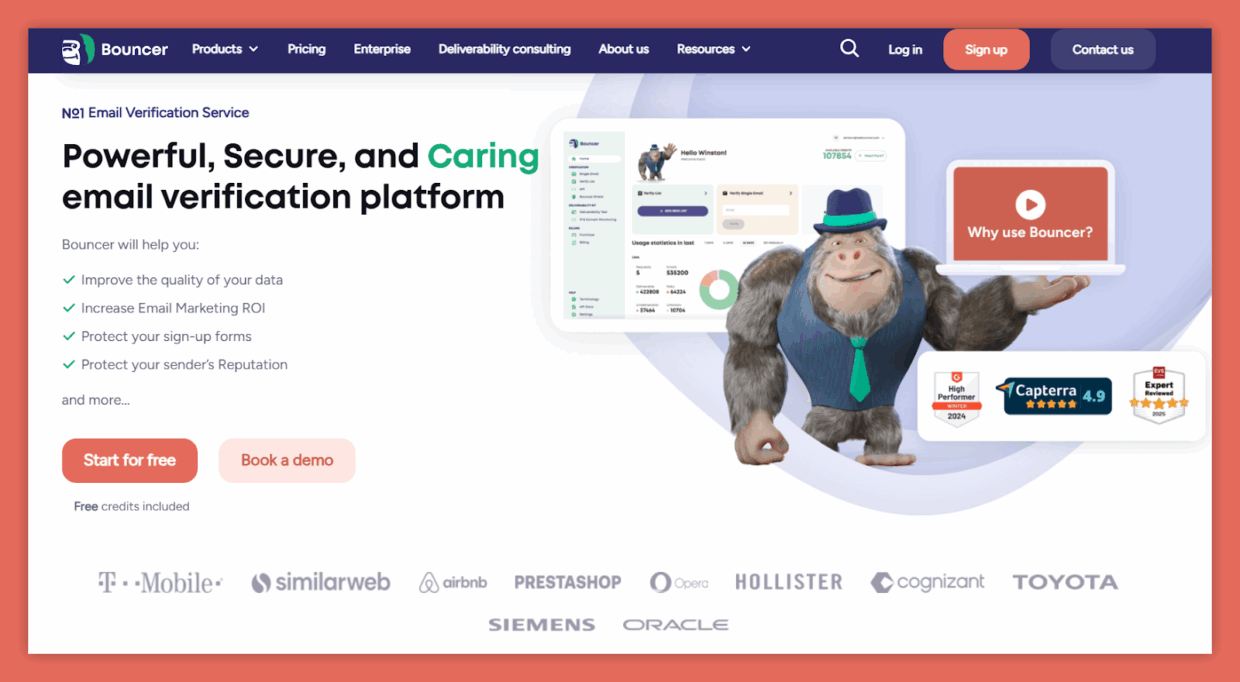
Key features that optimize email campaigns
- Email verification & validation
Bouncer checks every email on your list to confirm it’s valid and deliverable. It removes risky addresses like disposables and spam traps. With advanced domain verification and MX record checks, you can be confident that your list is 100% optimized before hitting send.
- Catch-all handling
Unlike many competitors, Bouncer excels at identifying catch-all domains (like Google Workspace and Office365), providing accurate results where others often return “unknown.” This reduces bounce rates and keeps your sender reputation clean.
- Deliverability reports
Go beyond basic validation with insights that help you optimize email campaigns. Bouncer’s deliverability reports highlight potential risks and ways to keep your sender score high.
- Seamless integrations
Bouncer works perfectly with your existing tools. No matter if it’s CRM integration, email marketing platforms, or productivity apps, you’ll save time by verifying contacts directly in your workflow. There’s even a Google Sheets add-on that makes bulk verification effortless for teams working in spreadsheets.
- Email automation ready
With a robust API and native integrations, Bouncer fits right into your email automation processes. You can verify new signups in real-time or run regular batch checks to maintain list hygiene automatically.
- Data security you can trust
Bouncer is fully GDPR, SOC2, and HIPAA compliant, with end-to-end encryption to protect your customer data. Security and trust are at the heart of every verification.
- Affordable pricing with free options
Bouncer is built for businesses of all sizes. Its affordable pricing and flexible plans make it a great choice whether you’re a freelancer, startup, or enterprise. You can start risk-free with a free plan or a free pricing trial, letting you test features before committing.

Helpful customer service
Beyond technology, what makes Bouncer truly unique is its people. Users consistently praise its helpful customer service, describing the team as responsive, caring, and proactive in helping optimize results.
So if you’re looking for the most accurate bulk email verifier, Bouncer should be your first choice. It helps you:
- clean your lists and avoid risky addresses
- improve deliverability and optimize email campaigns
- secure your sender reputation
- save time with seamless integrations into your existing tools
- scale cold email campaigns and lead generation with confidence
With its blend of accuracy, speed, security, and customer care, Bouncer is the backbone of successful outreach in 2026 and beyond.

Instantly – email finder and outreach platform
Instantly has become popular among sales teams and agencies looking for an all-in-one platform for cold emailing. Beyond scheduling outreach campaigns, rotating inboxes, and managing unlimited sending accounts, Instantly also includes a built-in email verification service.
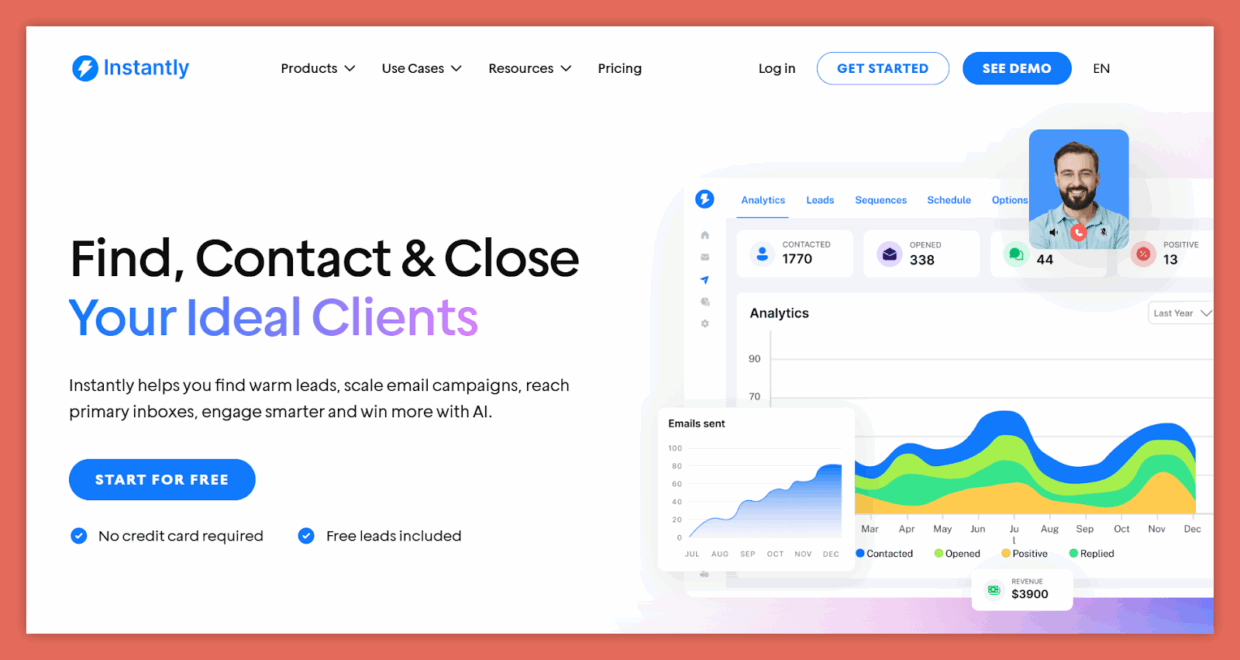
Pros of Instantly
- Verification is fully embedded inside the outreach workflow, which means you don’t need to juggle multiple tools or export/import lists.
- The tool automatically detects hard bounces and obvious syntax errors, helping maintain a cleaner list.
- Instantly tries to recover leads from domains that normally hide whether individual inboxes exist.
- Instead of locking users into large bulk subscriptions, Instantly keeps costs tied to actual verification volume.
- Freelancers, startups, or agencies running everything inside Instantly gain a user friendly interface that combines outreach and verification in one place.
Cons of Instantly
- The verifier is tightly linked to Instantly’s platform. If your sales or marketing operations rely on CRMs, lead finder tools, or multi-channel outreach, you won’t get the same flexibility as with standalone top email verification tools.
- While it works for campaign-ready lists, it isn’t designed for cleaning hundreds of thousands of old contacts or legacy databases.
- Compared to dedicated solutions, Instantly lacks layers such as full SMTP simulations, spam detection, or detailed risk scoring for invalid domains and risky email addresses.
- Developers won’t find broad email verification API access here, which can be a limitation for enterprises needing custom pipelines or external automation.
Instantly’s verification is a helpful addition for teams already using the platform for outreach.
It keeps campaign lists cleaner, reduces obvious invalid emails, and lowers bounce rates without extra complexity.
However, keep in mind it is not a replacement for standalone email verification software if you need bulk verification, real-time verification across multiple sources, or advanced analytics to protect sender reputation at scale.
Respona – email marketing tool with domain search
Respona is best known as an all-in-one tool for link building, PR outreach, and affiliate recruiting. Its email verification software is not a standalone product but a feature built directly into the outreach workflow.
Using an SMTP check, Respona validates email addresses in real time before contacts are added to a sequence. This helps avoid bounces during cold emailing or bulk outreach without leaving the platform.
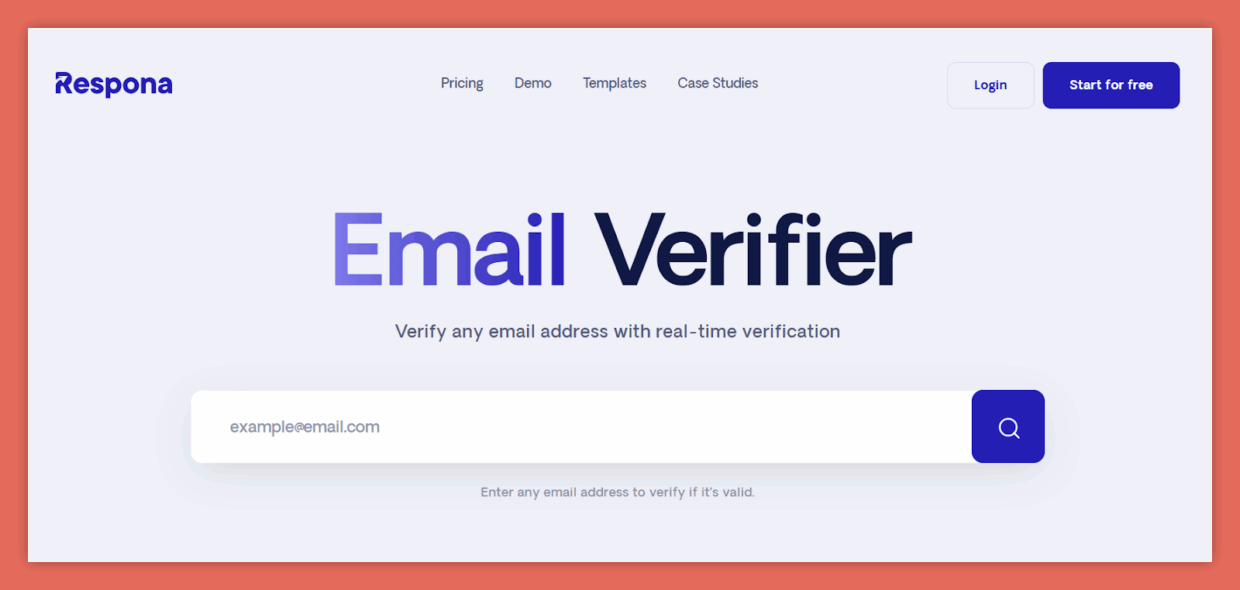
Pros of Respona
- Verification happens automatically once you find a prospect, saving time when building lists for outreach campaigns.
- The verifier connects to the recipient’s SMTP server, testing domain status, format, catch-all detection, and deliverability.
- Particularly useful in link building or journalist outreach where data freshness matters.
- Up to 5 email verifications per day at no cost, which is enough for testing workflows or smaller campaigns.
- Teams running their outreach end-to-end inside Respona benefit from a seamless process.
Cons of Respona
- It lacks many features found in top email verification tools, such as spam trap detection, bounce prediction, or risk scoring.
- You can’t upload and cleanse large lists of email addresses or export full verification reports.
- There’s no email verification API access, no Google Sheets plugin, and limited integrations with external CRMs or email marketing platforms.
- Results stop at valid/invalid checks, with little data on disposable emails, role-based inboxes, or risky domains.
- To scale, you must buy into Respona’s broader outreach package, which may be overkill if you only need email validation.
Respona’s email verifier is functional but narrow. It adds value to teams already committed to using the platform for cold emailing, link building, or affiliate recruiting. For that audience, having verification baked into the workflow is a plus.
But for teams seeking bulk verification, deeper reporting, or flexible integrations with sales engagement platforms and marketing tools, Respona is too limited. In that case, a dedicated solution like Bouncer provides more accuracy and a broader toolset for maintaining sender reputation and ensuring deliverability.
lemlist – cold emailing with built-in verification
lemlist is widely recognized as a sales engagement platform for cold emailing, complete with features such as email warm-up and campaign templates. As part of this ecosystem, the lemlist Verifier helps improve email deliverability by cleaning lists and reducing bounce rates.
Unlike some tools, it uses a “waterfall enrichment” method to combine multiple data sources, producing up to 40–55% more valid email addresses than traditional verifiers.

Pros of lemlist
- Combines first name, last name, company, or even LinkedIn profile data to find and verify contacts.
- Supports batch verification, which is helpful for agencies managing multiple outreach campaigns.
- Works directly with lemlist’s prospecting tools, reducing friction between lead discovery and email validation.
- Goes beyond simple SMTP pings by cross-checking several email service providers for higher accuracy.
- Users get 500 credits free to test the tool before committing to paid plans.
Cons of lemlist
- You can’t purchase the verifier as a standalone tool as it’s locked into lemlist’s broader cold emailing packages.
- A credit-based system adds costs quickly. For example, verifying and enriching just 10 emails may consume 40 credits.
- The cheapest plan includes only 100 credits per month, which is insufficient for teams handling bigger datasets.
- Some users note lag during bulk verification and a less polished, user-friendly interface.
- While powerful, the interface can feel confusing for beginners, requiring time before teams see results.
- Unlike dedicated email verification tools, lemlist lacks API access, wide integrations, or export flexibility.
lemlist Verifier is most useful for teams already running cold email outreach inside the platform and looking for a combined approach to email verification and campaign management. The extra data enrichment makes it stronger than simple syntax checkers, and bulk verification can support mid-size campaigns.
However, the pricing structure, limited credits, and bundled package make it less attractive as a pure email verification service. For businesses that want flexible, scalable, and cost-efficient bulk email verification across multiple platforms, options like Bouncer are usually the better choice.
ZeroBounce – trusted email validation and catch-all detection
ZeroBounce, founded in 2015, is a widely used email verification service known for its strong security standards and broad feature set. It checks whether emails are valid, deliverable, or risky, and is trusted by companies across industries.
The tool covers basics like syntax, domain, MX, and SMTP checks, along with extras such as disposable email detection and spam trap identification. On paper, it looks like a complete package. But in practice, it has some drawbacks you should be aware of.

Pros of ZeroBounce
- Detects disposable emails, spam traps, complainers, role-based addresses, and duplicates.
- GDPR, SOC2, and HIPAA certified; encrypted data handling.
- 60+ integrations (e.g., MailChimp, Constant Contact) plus API access for batch or real-time checks.
- Many users highlight responsive, helpful customer service.
- Performs well with Gmail and Yahoo accounts, with near-perfect accuracy there.
Cons of ZeroBounce
- Claims 99%, but independent tests place it closer to 90% overall, and much lower (~58%) for catch-all domains.
- Around 110 minutes per 10,000 emails, which is significantly slower than top competitors.
- Doesn’t publish detailed performance benchmarks for spam trap detection or niche providers.
- Some users report that the setup and workflow aren’t intuitive, especially with large lists.
- Verifying very large lists often requires splitting files, which can slow down workflows.
ZeroBounce offers a comprehensive toolkit for email validation and is especially strong on security and integrations. It’s a safe choice for businesses with strict compliance needs or smaller lists where speed isn’t critical.
However, the slower processing times and variable accuracy outside of Gmail/Yahoo make it less competitive in 2026 compared to faster and more precise tools like Bouncer. If you manage large databases or need verification at scale, you may want to explore alternatives that deliver higher accuracy and faster turnaround.
NeverBounce – reliable disposable email detection
NeverBounce has been around since 2014 and is one of the most well-known names in email list cleaning and real-time verification. Backed by ZoomInfo and trusted by big brands like Uber, Dell, and Doordash, it built its reputation as a reliable solution for reducing bounces and keeping databases clean.
The platform supports both bulk list uploads and real-time API verification, making it useful for marketers who want to clean existing lists as well as stop invalid signups at the point of entry. Despite its popularity, however, the tool is showing signs of lagging behind newer alternatives in terms of accuracy and pricing flexibility.
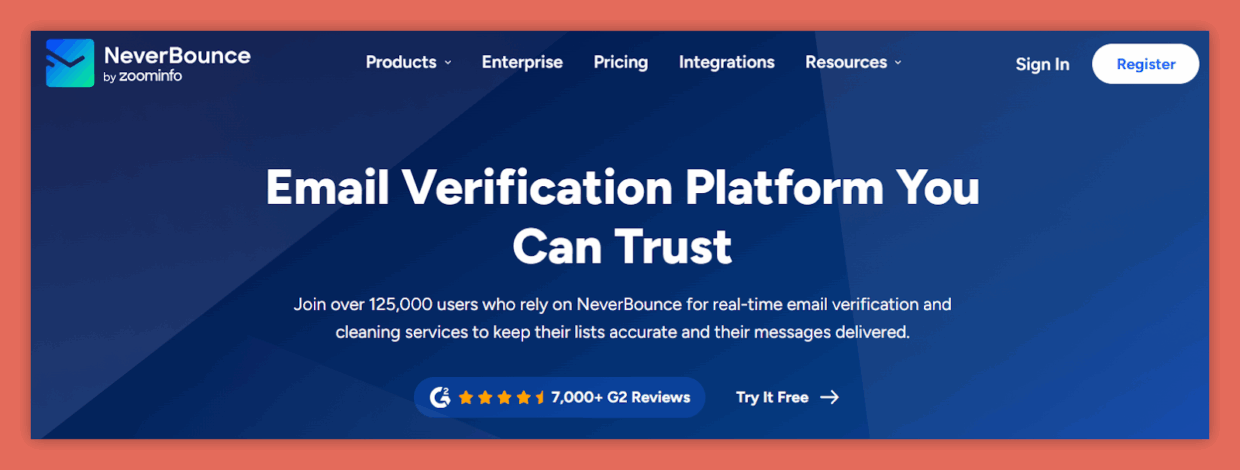
Pros of NeverBounce
- Long-standing reputation in the email validation space.
- Removes invalid, outdated, or risky addresses from large databases.
- Blocks invalid or disposable emails at signup to protect sender reputation.
- Built with integrations and scale in mind, making it suitable for high-volume senders.
- Users often highlight its convenience and straightforward workflow.
Cons of NeverBounce
- Reported accuracy is around 93%, which falls short of leading tools that exceed 99%.
- Struggles with certain providers (e.g., Yahoo addresses) and can be slower with large lists (10,000 emails in ~50 minutes).
- Some reviews cite poor customer support and delayed issue resolution.
- $8–10 per 1,000 verifications makes it more expensive than several stronger alternatives.
- Purchased credits expire after 12 months, reducing flexibility for occasional users.
NeverBounce remains a recognizable player in the email verification market, especially for companies that value its real-time API integration and long-standing reputation. However, its accuracy and speed no longer stack up against newer solutions, and the pricing structure makes it harder to justify for high-volume campaigns.
If you need a familiar, enterprise-tested option, NeverBounce might still serve. But if you’re focused on cost-effectiveness and accuracy above 99%, alternatives like Bouncer offer a more compelling package in 2026.
Hunter – domain search and email finder for outreach
Hunter is best known as a prospecting tool that helps you discover professional email addresses by entering a person’s name or company domain. Alongside its popular email finder, Hunter also includes an email verification tool used to confirm if those addresses are valid and safe to use in cold email outreach.
The verification process covers common checks like SMTP connections, MX record lookups, and invalid address detection. Each result is accompanied by a confidence score and deliverability status, giving users an indication of whether an email is risky to contact.
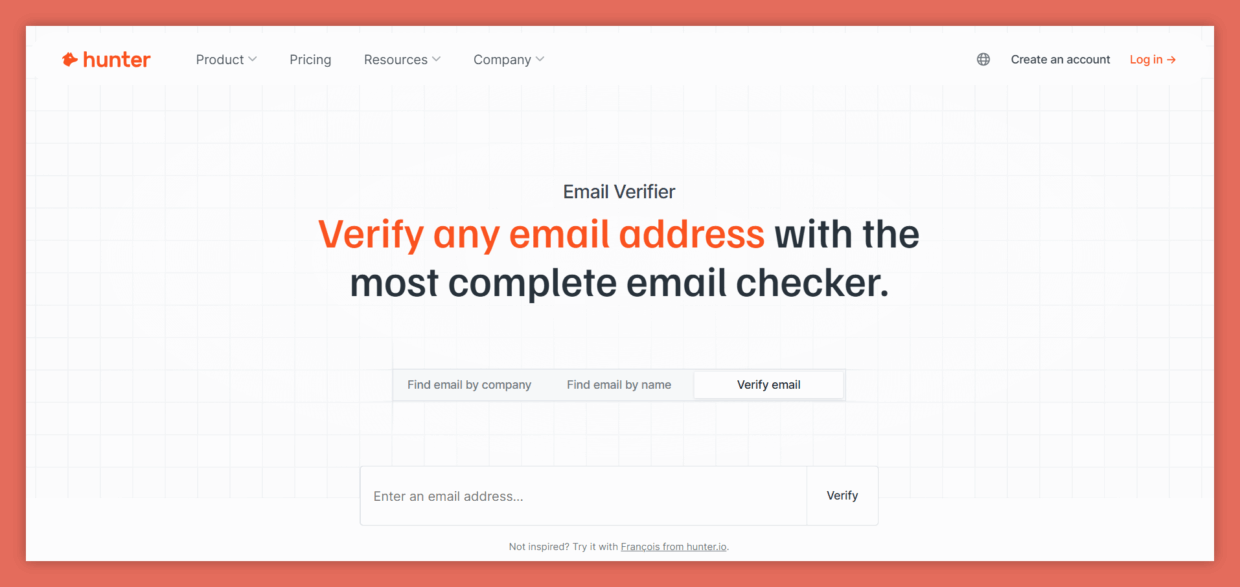
Pros of Hunter
- Ideal for users who don’t already have email lists, since it can both find and verify email addresses.
- Assigns a probability to each email, helping you prioritize outreach.
- Works with Google Sheets, Zapier, CRMs, and other platforms to sync results into your existing workflow.
- Supports CSV uploads for list cleaning, making it useful for outreach campaigns at scale.
- Delivers verification status, deliverability risk, and a clear overview of each address.
Cons of Hunter
- Hunter does not publish detailed performance metrics, leaving reliability somewhat uncertain.
- Lacks deeper checks like toxicity scoring, spam trap detection, or disposable email filtering offered by dedicated tools.
- Works well if you’re finding new contacts, but less competitive if you simply want to validate a large existing database.
- While helpful, the scoring is less detailed than full risk-level analysis available from specialized email verifiers.
- Verification is bundled with Hunter’s broader suite, which may feel excessive if you only need list hygiene.
Hunter is a practical choice for sales teams and link builders who want a two-in-one solution: finding professional emails and validating them in the same place. The confidence score adds a useful extra layer for prioritizing leads, and integrations with Google Sheets and CRMs make it easy to plug into outreach workflows.
That said, as a pure email verification tool, Hunter lacks some of the advanced checks and large-scale efficiency that software like Bouncer offers. If your main goal is discovering contacts, Hunter fits the bill. If you already have a database and want to focus on accuracy and deliverability, a dedicated verifier may be the stronger option.
Which tool should you pick?
The answer depends on how you run your outreach.
- If accuracy and deliverability are your top priorities, Bouncer is the strongest choice. It leads on precision, handles catch-all domains better than most, and fits smoothly into existing workflows with integrations and API access.
- If you want verification bundled inside an outreach platform, tools like Instantly, Respona, or lemlist make sense, but keep in mind they’re tied to those ecosystems.
- If you need a familiar brand with a long history, ZeroBounce or NeverBounce may be appealing, though they’re slower and less accurate than newer options.
- If your focus is on finding new leads and validating them right away, Hunter gives you both in one place.
For most teams serious about cold outreach in 2026, Bouncer offers the best mix of accuracy, speed, flexibility, and care for your sender reputation. It’s the kind of tool that not only cleans your list but also helps your campaigns land in the inbox.
Don’t wait, try it for free now. 100 free credits are one click away.


